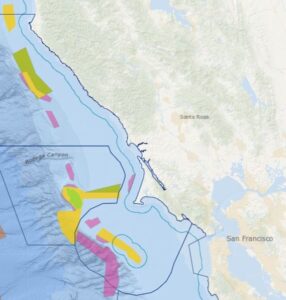
For the first time in recent years, the Pacific Fishery Management council is proposing new fisheries openings in soft bottom areas to be accompanied by new fisheries closures in rocky areas along the US West Coast. Deep-sea benthic surveys conducted by NOAA and USGS partners off the US Pacific Coast since 2012 were cited as an integral part of the new management measures. The decision was based on this and other collaborative research with full support of the fishing community.
The Council decided to close 16,000 square miles off Southern California to bottom trawling to protect deep-sea corals there, while also opening small areas of sandy bottom to trawl fishermen in Northern California. Key outcomes for NOAA occurred in the Greater Farallones National Marine Sanctuary (GFNMS), where seven new areas were closed to bottom trawling totaling almost 178 square miles (see Figure). Two areas were “re-opened” to fishing where there is believed to be soft, sand and mud habitat. Proposals for these modifications cited scientific publications by several NOAA scientists. NOAA only provided the scientific data and did not make specific recommendations for these proposals.
Related scientific publications:
Graiff, K., D. Lipski, P. Etnoyer, G. Cochrane, G. Williams, E. Salgado. 2016. Benthic Characterization of Deep-Water Habitat in the Newly Expanded Areas of Cordell Bank and Greater Farallones National Marine Sanctuaries. Marine Sanctuaries Conservation Series ONMS-16-01. U.S. Department of Commerce, National Oceanic and Atmospheric Administration, Office of National Marine Sanctuaries, Silver Spring, MD. 38 pp.
Etnoyer, P. J., Cochrane, G., Salgado, E., Graiff, K., Roletto, J., Williams, G., Reyna, K., Hyland, J. December 2014. Characterization of deep-coral and sponge communities in the Gulf of the Farallones National Marine Sanctuary: Rittenburg Bank, Cochrane Bank, and the Farallon Escarpment. NOAA Technical Memorandum NOS NCCOS 190. NOAA National Centers for Coastal Ocean Science, Charleston, SC. 36 p.
This is a key example of science informing policy. The work used funding from Deep Sea Coral Research and Technology Program, Office of Ocean Exploration, and National Centers for Coastal Ocean Science.
Contact: peter.etnoyer@noaa.gov, karen.reyna@noaa.gov
